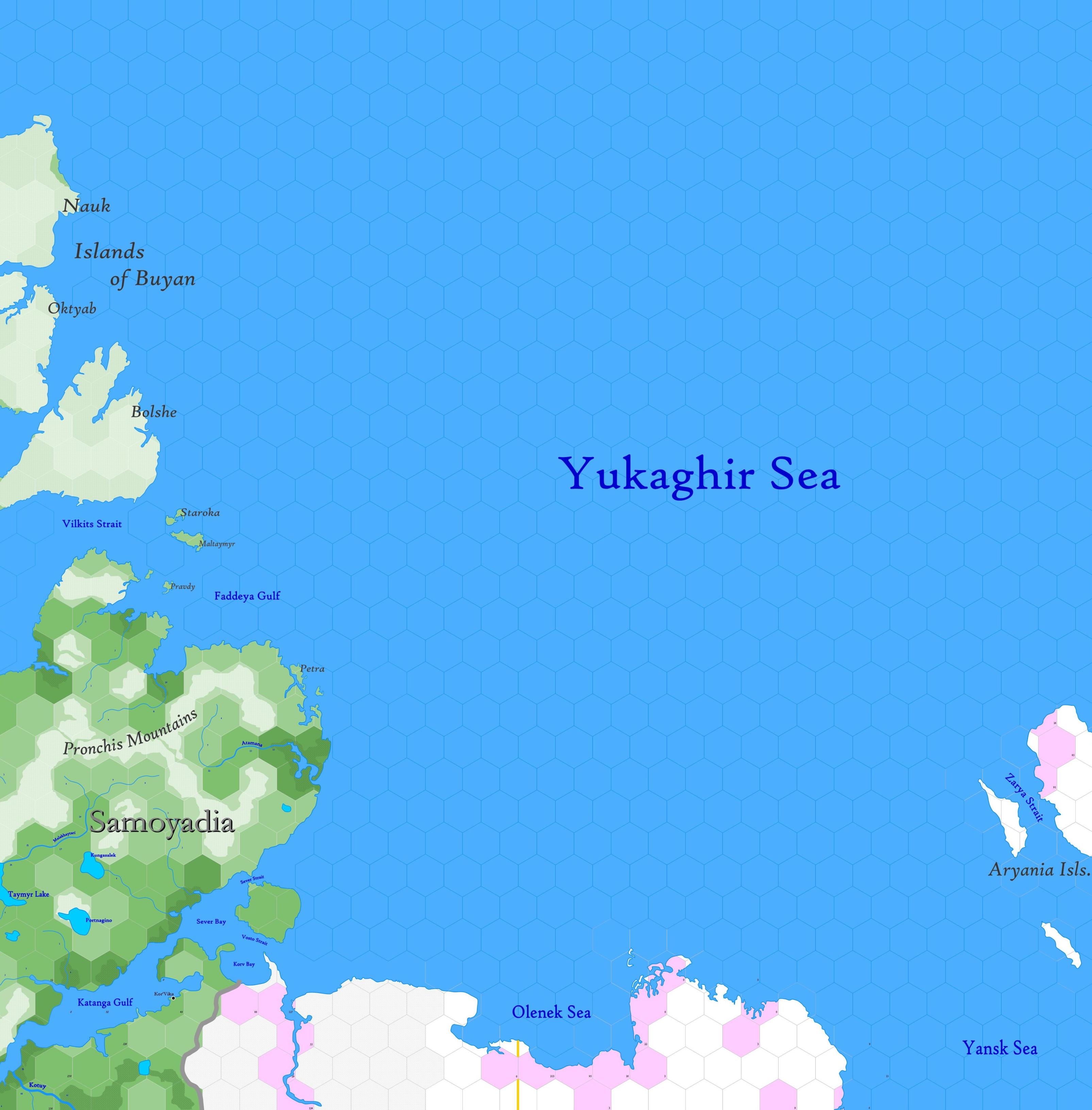Map A.05 - Yukaghir Sea
Incomplete Map. Reaching from 82.34°N south to 72.51°N, the area covers a remote and largely uncharted region in the Arctic, including portions of the Samoyad Peninsula, the northern coastline of Sakha, part of Trakkatch Dran, and the unmapped Islands of Aryania along the eastern edge. These lands are characterised by extreme cold, polar ice, and potentially unique ecosystems.
These lands would be considered a realm of great mystery and danger. To venture into this territory, explorers would require specialized knowledge of cold-weather survival, along with well-equipped expeditions consisting of skilled adventurers, cartographers, and perhaps even a few mystics or seers to guide them. The harsh climate, lack of knowledge about the terrain, and the inhabitants would make this expedition exceptionally challenging.
Still, the allure of discovering new lands and the potential for valuable resources or hidden wonders might drive adventurers to embark on such a perilous journey. They would hope to make significant geographic, mystical or magical discoveries in this remote and unexplored realm.
Hexes are 20 miles in diameter. Total area depicted equals 366,450 sq.m.
Buyan
The Buyan Islands, shown partial on the left side of the map, are mythical lands still unknown to Europeans; even denizens of the nearby mainland know very little about the archipelago due to their harsh polar climate. Legend has it that these islands possess the extraordinary ability to appear and disappear at will.
Another myth states that the Buyan Islands are the abode of three demi-god brothers, each representing a cardinal wind - northern, western, and eastern. Their names are Bolshe, Nauk, and Oktyab, and the islands that each dwells upon shares its name with the brother.
Yet another myth tells that the islands are the dwelling place of the Zoryas, solar demi-goddesses who are the daughters of the solar god Dazhbog. Utrennyaya, goddess of the morning star, opens the gates of the heavenly palace to the east, allowing the sun to rise and bring daylight to the world. Her syster Vechernyaya, goddess of the evening star, closes the heavenly gates at dusk, allowing the sun to rest and for darkness to cover the world. A third sister, Polunochnaya, goddess of the midnight star, guards the gates at night. The Zoryas' stories are deeply intertwined with Slavic mythology and reflect the reverence for celestial bodies and the cyclical nature of the universe.
Pronchis Mountains
The Pronchis Mountains are an eastern extension of the Byranga Plateau within Samoyadia, remote mountain range located in the Taymyr Peninsula, part of the Russian Arctic. Stretching approximately 400 kilometers in a north-south direction, these rugged mountains feature peaks reaching elevations of around 3,900 to 5,200 ft. Situated in an extreme Arctic climate, the region is marked by permafrost, sparse vegetation and glaciers.
Yukaghir Sea
An arm of the Arctic Ocean bounded by Samoyadia on the west and Trakkatch Dran on the south. The sea is shallow, no deeper than 12-13 fathoms as far out as 30 mi. from shore. The Yansk Sea is free of ice and open for navigation from the east during August and most of September, though pack ice and bergs may be carried into it from the frozen west sea. The Yukaghir Sea cannot be entered from the west, as it remains frozen or nearly so the year round.
Provinces
Samoyadia
The Kingdom of Samoyadia is a gnoll realm and homeland of the gnoll people, in the furthest north of Siberia. Temperature ranges from very cold in the winter to chilly in July. The population is largely gnoll in race, but some norker clans can be found along the border with Sakha. Fauna includes reindeer, wolves, polar bears, ermine and migratory birds; transhumance is practiced among copious reindeer herds that move to foothills of the Pronchis Mountains in summer and southwestward in the winter. The immense kingdom has an area of 730.7 hexes and a population of 15,625.
Adjacent Maps
| A4: Kara Sea | A5: Yukaghir Sea | A6: Aryania | |
|---|---|---|---|
| B6: Tunguska | B7: Verkhoy Range | ||
See Sheet Maps
